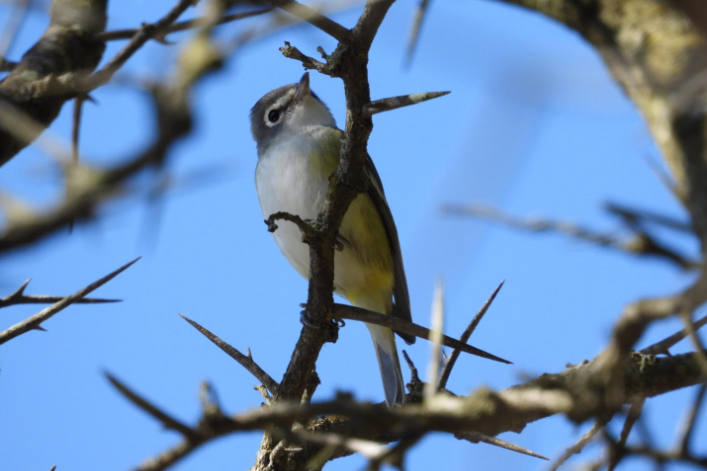The Many Faces of a Familiar Bird
By Olivia Bautch
Love it or hate it, it’s been highly debated- should birds named after people get new names?
Determining this had been the years-long process of the American Ornithological Society (AOS). Social justice movements gaining ground in 2020 caused many in the greater society to question the commemoration of historical figures with ties to slavery and oppression. The first sign of this social movement infiltrating bird taxonomy was the change of McCown’s Longspur to Thick-billed Longspur. Although twenty years earlier, Long-tailed Duck replaced that diving duck’s previous “Oldsquaw” title, which was a slur to some of the biggest conservation allies of the bird- native peoples.
The ultimate decision of the AOS was made in October of 2023 to change all English-language bird names in the US and Canada with eponyms (that is, they are named after people), through a diverse committee.
The common threads among all instances are eponyms, questionable histories, and the intention to create a more inclusive and respectful environment for bird lovers. Does this simultaneously create inconsistency among guides, lists, and generations, and even confusion for new birders? I don’t think it’s wrong to admit that for a time, yes, it will. But it helps to remember that this is not the first time that bird names have been changed.
***
I never really thought about bird name changes until I purchased an Audubon print in a Minnesota antique shop. The bird was obviously a Blue-headed Vireo- blue head, white spectacles, olive back- but I almost doubted my identification for the large-beaked passerine whose name in script read “Solitary Flycatcher”.
We find that John James Audubon included this plate in his influential 1840 work, The Birds of America. At the time of publishing this bird was classified as the Solitary Vireo, a widespread species that was eventually broken, or split, into three similar-looking but regionally separate vireos.
So here we have, over several centuries, three different names for one species. Yet the eponymous evolution of this species was not a “solitary” event. Imagine going from Green Wren to White-eyed Vireo. Or from Great-footed Hawk to Peregrine Falcon. The reasoning behind several types of name changes can help us better understand the history of avian taxonomy as a whole.
Behaviors
The Solitary Flycatcher was first classified as a part of the Latin Muscicapa genus (the old world flycatchers) along with many other birds we now call vireos, modern tyrant flycatchers, and even several warblers. One of these birds is the familiar summer songster, our Red-eyed Vireo. A fragment from Alexander Wilson’s American Ornithology finds the famed ornithologist observing the varying foraging behaviors, energy, and song of flycatchers and vireos. In reading, these two families had apparently been recently split, and this commentary gives logical reason for that decision.
Hybridization
Later in 1942, the publication of Systematics and the Origin of Species defined what it meant for a species to be a species, highlighting the ability for two separate species to produce viable offspring. The possibility of successful hybridization lumped a large number of previously distinct species, such as the Baltimore and Bullock’s Orioles into one Northern Oriole. However, more recent studies do not hold this reasoning as highly as before. Boreal breeding Golden-wing and Blue-wing Warblers hybridize so often that their offspring are identified as an additional two species (Brewster’s and Lawrence’s Warblers), yet plumage differences keep golden-wing and blue-wing populations distinct.
Genomics
We know this because of the late-twentieth century rise of genome sequencing. This fairly recent technology gives scientists the ability to analyze entire sequences of DNA, comparing and contrasting to other species in question, and rearranging trees and genera. This is what ultimately split the Solitary Vireo in 1997, re-split the Northern Oriole, and maintained the eponymous dignity of the two aforementioned warbler species. The science is so accessible that each year the AOS makes several genetic-based taxonomic changes in an annual “Check-list Supplement” which are then implemented in American Birding Association and eBird databases
***
The transition to non-eponymous common names is still quite a way off. According to representatives at the AOS, it could be months or years before the official decisions. But that has us wondering two things… what should these birds be called? And what about misnomers like Ring-necked Duck or Red-bellied Woodpecker? Might they be changed in time?
In an attempt to answer question one, social groups and creative individuals have taken to social media to let their voice be heard. While proposed names range from cute to snarky to scientific, AOS commits to involving the public in their ultimate decisions. It is even possible that historical names like those given by Wilson and others may be dusted off and given new life, like the re-split and renamed Northern Goshawk, whose North American population, as of 2023, now retains its original American Goshawk title.
To tackle the second question, I asked several Amos Butler directors for their opinion. Here are their suggestions:
Jenna, communications chair, says “I can never remember the name of the Black-necked Stilt because when I picture it in my head, it has a white neck! I think it should be called the Pink-legged Stilt because that’s what stands out to me.”
Laurie, recording secretary, suggests a few names “change Nelson’s to Wetland Sparrow. LeConte’s to Sedge Sparrow. MacGillivray’s Warbler to Split-ringed Warbler, and Wilson’s Warbler to Black-capped or Yamaka Warbler.”
And Chuck, president, recommends for Ross’s Goose “Grin-less Goose. This name will help distinguish it from a Snow Goose.”
One thing we know for sure: this time around, the name of the Blue-headed Vireo (or Solitary Vireo, or Solitary Flycatcher- you choose) is not on the line. And even if it were, genomic analysis assures us that species that are over 99% similar haven’t let hybridization stop their species from continuing on for centuries. In the coming years our lists and field guides will receive what may be a strange new update, but when we stand in the forest beholding some newly-named passerine we will see familiar plumage, hear familiar sounds, and observe familiar behaviors. Suddenly, the many faces of that familiar bird might not matter so much.
References
https://abcbirds.org/bird/blue-headed-vireo/

